1. м„ң лЎ
мҪҳнҒ¬лҰ¬нҠёлҠ” нғҖм„Ө нӣ„ мҶҢмҡ”мқҳ к°•лҸ„ л°Ҹ н’Ҳм§Ҳмқ„ нҷ•ліҙн• л•Ң к№Ңм§Җ кұ°н‘ём§‘мқҙ н•„мҡ”н•ҳкі мҪҳнҒ¬лҰ¬нҠё мЈјмң„ мҳЁлҸ„ л°Ҹ мҠөлҸ„лҘј м Ғм Ҳн•ң лІ”мң„лЎң мң м§ҖмӢңмјң мЈјлҠ” м–‘мғқмқҙ н•„мҲҳм ҒмқҙлӢӨ(
Koh et al., 2005). мқҙлҹ¬н•ң м–‘мғқкё°к°„мқҖ мҪҳнҒ¬лҰ¬нҠё кө¬мЎ°л¬јмқ„ мӢңкіөн•ҳлҠ”лҚ° мһҲм–ҙм„ң кіөкё°лҘј кІ°м •н•ҳлҠ” мЈјмҡ” мҡ”мқёмңјлЎң мһ‘мҡ©н•ңлӢӨ. нҠ№нһҲ лҸҷм Ҳкё°м—җ мҷёкё°мҳЁлҸ„ 0 В°C мқҙн•ҳм—җм„ң мҪҳнҒ¬лҰ¬нҠёлҘј нғҖм„Өн•ҳлҠ” кІҪмҡ° нғҖм„Ө мҙҲкё° л°°н•©мҲҳмқҳ лҸҷкІ°лЎң мқён•ҙ лҸҷн•ҙлҘј мһ…кІҢ лҗҳкі кІҪнҷ”м§Җм—°мңјлЎң к°•лҸ„л°ңнҳ„мқҙ лҠҗлҰ¬кІҢ лҗҳл©°, мқҙлҠ” мөңмў…м ҒмңјлЎң мҪҳнҒ¬лҰ¬нҠёмқҳ лӮҙкө¬м„ұмқ„ м Җн•ҳн•ҳлҠ” мҡ”мқёмңјлЎң мһ‘мҡ©н•ңлӢӨ(
MOLIT, 2016). л”°лқјм„ң, мҪҳнҒ¬лҰ¬нҠё н‘ңмӨҖмӢңл°©м„ңм—җм„ңлҠ” мқј нҸүк· кё°мҳЁмқҙ 4 В°C мқҙн•ҳмқј кІҪмҡ° н•ңмӨ‘мҪҳнҒ¬лҰ¬нҠёлЎң кҙҖлҰ¬н•ҳлҸ„лЎқ н•ҳкі мһҲмңјл©° кҙҖлҰ¬м§Җм№ЁмңјлЎң нғҖм„Ө мҰүмӢң ліҙнҳёмЎ°м№ҳлҘј м·Ён•ҳкі , көім§Җм•ҠмқҖ н‘ңл©ҙмқҖ нғҖм„Ө нӣ„ мөңмҶҢ 24мӢңк°„ лҸҷм•Ҳ лҸҷкІ°лҗҳм§Җ м•ҠлҸ„лЎқ ліҙмҳЁн•ҙм•ј н•ңлӢӨкі лӘ…мӢңн•ҳкі мһҲлӢӨ(
MOLIT, 2016). н•ңнҺё
ACI Committee 306R (1988)м—җм„ңлҠ” мқјнҸүк· кё°мҳЁмқҙ 5 В°C мқҙн•ҳ л°Ҹ 24мӢңк°„мқҳ м Ҳл°ҳ мқҙмғҒмқҙ 10 В°C мқҙн•ҳмқё кІҪмҡ°к°Җ 3мқј мқҙмғҒ м§ҖмҶҚ лҗ л•ҢлҘј Cold WeatherлЎң м •мқҳн•ҳкі мһҲлӢӨ.
мҪҳнҒ¬лҰ¬нҠёмқҳ м–‘мғқкё°к°„мқҖ мҪҳнҒ¬лҰ¬нҠёмқҳ мҲҳнҷ”л°ҳмқ‘ мҶҚлҸ„м—җ мқҳн•ҙ мўҢмҡ°лҗҳл©°, мқҙлҹ¬н•ң мҲҳнҷ”л°ҳмқ‘мқҖ м–‘мғқмҳЁлҸ„м—җ л”°лқј нҒ¬кІҢ ліҖнҷ”н•ҳлҜҖлЎң лҸҷм Ҳкё°м—җлҠ” мӢңкіө мӨ‘ мҳЁлҸ„лҘј кі л Өн•ҳм—¬ мқёмң„м ҒмңјлЎң м–‘мғқмҳЁлҸ„лҘј лҶ’м—¬мЈјлҠ” м ңм–ҙм–‘мғқ кё°мҲ мқҙ н•„мҡ”н•ҳлӢӨ(
Koh et al., 2005,
2014). мқјл°ҳм ҒмңјлЎң кұҙм„Өнҳ„мһҘм—җм„ңлҠ” кіөк°„ к°Җм—ҙлІ•(м—ҙн’Қкё°, нһҲн„°, к°Ҳнғ„ л“ұ нҷңмҡ©), н‘ңл©ҙ к°Җм—ҙлІ•(л°ңм—ҙмҡ© мӢңнҠё, мҳЁмғҒм„ л“ұ нҷңмҡ©), мҰқкё°м–‘мғқ л“ұмқҙ нҷңмҡ©мқҙ лҗҳкі мһҲмңјл©°(
KCI, 2015), нҠ№мҲҳн•ң л°©лІ•мңјлЎң к°•мһ¬ кұ°н‘ём§‘ л°Ҹ мҪҳнҒ¬лҰ¬нҠё лӮҙл¶Җ мІ к·јм—җ м „м—ҙм„ мқ„ л¶Җм°©н•ҳм—¬ мҳЁлҸ„лҘј м ңм–ҙн•ҳлҠ” л°©лІ• л°Ҹ л§ҲмқҙнҒ¬лЎңмӣЁмқҙлёҢ л°ңм—ҙкұ°н‘ём§‘ л°©лІ• л“ұлҸ„ к°ңл°ңмқҙ лҗҳм–ҙ нҳ„мһҘм Ғмҡ© мӮ¬лЎҖк°Җ ліҙкі лҗҳкі мһҲлӢӨ (
Kang et al., 2009;
Koh et al., 2014). мқҙлҹ¬н•ң л°©лІ•л“ӨмқҖ лҢҖл¶Җ분 л°ңм—ҙмІҙмқҳ л°ңм—ҙм—җ мқҳн•ҙ м—җл„Ҳм§ҖлҘј м „лӢ¬н•ҳлҠ” л°©мӢқмңјлЎң м—ҙмҶҗмӢӨмқҙ нҒ¬кі нҷ”мһ¬м—җ лҢҖн•ң мң„н—ҳмқҙ мЎҙмһ¬н•ңлӢӨ. лҳҗн•ң, мқјл¶Җ л°©лІ•мқҳ кІҪмҡ° мң н•ҙк°ҖмҠӨ л°ңмғқм—җ л”°лҘё мһ‘м—…мһҗмқҳ м•Ҳм „л¬ём ң, нҷ”м„қм—°лЈҢ мӮ¬мҡ©м—җ л”°лҘё нҷҳкІҪмҳӨм—ј л¬ём ң, кі л№„мҡ© л¬ём ң л“ұмқҳ н•ңкі„лҘј к°Җм§Җкі мһҲлӢӨ.
ліё м—°кө¬м—җм„ңлҠ” кё°мЎҙ м ңм–ҙм–‘мғқ кё°мҲ л“Өмқҳ лӢЁм җмқ„ ліҙмҷ„н•ҳкё° мң„н•ң л°©м•ҲмңјлЎң к°ңл°ңлҗң мң лҸ„к°Җм—ҙ(Induction Heating)мқ„ мқҙмҡ©н•ң л°ңм—ҙм–‘мғқ кё°мҲ мқҳ м–‘мғқ нҡЁмңЁм„ұмқ„ нҸүк°Җн•ҳмҳҖлӢӨ. мң лҸ„к°Җм—ҙ кё°лІ•мқҖ мң лҸ„мҪ”мқјм—җ нқҗлҘҙлҠ” кі мЈјнҢҢ м „лҘҳм—җ мқҳн•ҙ л°ңмғқн•ҳлҠ” мһҗмҶҚкіј мӢңк°„м—җ л”°лқј ліҖнҷ”н•ҳлҠ” мһҗмҶҚм—җ мқҳн•ҙ мң лҸ„лҗҳлҠ” мҷҖм „лҘҳ(Eddy Current)лҘј нҶөн•ҙ л°ңмғқн•ҳлҠ” мӨ„(Jule)м—ҙмқ„ мқҙмҡ©н•ҳм—¬ н”јк°Җм—ҙмІҙлҘј м§Ғм ‘м ҒмңјлЎң к°Җм—ҙмӢңнӮӨлҠ” л°©лІ•мқҙлӢӨ(
Lee et al., 2019;
Kim et al., 2020). мң лҸ„к°Җм—ҙ мӢңмҠӨн…ң л°Ҹ лҸҷмһ‘ мқҙлЎ мғҒм„ёлҠ” м„ н–үм—°кө¬(
Kim et al., 2020)м—җм„ң нҷ•мқёмқҙ к°ҖлҠҘн•ҳл©°, мөңк·ј к°Җм •м—җм„ңмқҳ мЎ°лҰ¬кё°кө¬ л°Ҹ л°ҳлҸ„мІҙ, кёҲмҶҚмӮ°м—…м—җм„ң нҷңл°ңнһҲ мқҙмҡ©мқҙ лҗҳкі мһҲлҠ” кё°мҲ мқҙлӢӨ. мқҙлҹ¬н•ң мң лҸ„к°Җм—ҙ кё°л°ҳ л°ңм—ҙм–‘мғқмқҳ кІҪмҡ° к°Җм—ҙмІҙк°Җ кёҲмҶҚмһ¬м§Ҳмқҳ кұ°н‘ём§‘мқ„ л№„м ‘мҙүмӢқмңјлЎң к°Җм—ҙн•ҳлҠ” л°©лІ•мңјлЎң м•Ҳм „м„ұмқҙ лҶ’кі , к°Җм—ҙмІҙлҠ” л°ңм—ҙн•ҳм§Җ м•ҠмқҖ мғҒнғңлЎң кұ°н‘ём§‘л§Ңмқ„ мң лҸ„н•ҳм—¬ л°ңм—ҙмӢңнӮӨлҜҖлЎң м—ҙмҶҗмӢӨ мөңмҶҢнҷ” л°Ҹ к°Җм—ҙмӢңк°„мқ„ лӢЁм¶•н• мҲҳ мһҲлҠ” нҡЁкіјк°Җ мһҲлӢӨ.
м„ н–үм—°кө¬лҘј нҶөн•ҙ,
Lee et al. (2019)мқҖ мң лҸ„к°Җм—ҙмқ„ мқҙмҡ©н•ң л°ңм—ҙм–‘мғқм—җм„ң, м–‘мғқ мөңкі мҳЁлҸ„, мөңкі мҳЁлҸ„ мң м§ҖмӢңк°„мқ„ ліҖмҲҳлЎң м–‘мғқ нӣ„ мҪҳнҒ¬лҰ¬нҠёмқҳ 압축강лҸ„ нҠ№м„ұмқ„ нҸүк°Җн•ҳм—¬ мөңм Ғмқҳ м–‘мғқкіЎм„ мқ„ м ңмӢңн•ҳмҳҖлӢӨ. лҳҗн•ң, кёҲмҶҚмһ¬м§Ҳ кұ°н‘ём§‘мқҳ мў…лҘҳ л°Ҹ л‘җк»ҳм—җ л”°лҘё мң лҸ„к°Җм—ҙ м„ұлҠҘмқ„ нҸүк°Җн•ҳмҳҖмңјл©°, 강섬мң ліҙк°• мҪҳнҒ¬лҰ¬нҠём—җ лҢҖн•ң мң лҸ„к°Җм—ҙ м–‘мғқ мӢӨн—ҳмқ„ нҶөн•ҙ мҷёл¶Җ кёҲмҶҚмһ¬м§Ҳмқҳ кұ°н‘ём§‘лҝҗл§Ң м•„лӢҲлқј лӮҙл¶Җмқҳ 강섬мң м—ӯмӢң мң лҸ„лҘј нҶөн•ҙ к°Җм—ҙмқ„ мӢңнӮ¬ мҲҳ мһҲлҠ” к°ҖлҠҘм„ұм—җ лҢҖн•ҙм„ң м ңмӢңн•ҳмҳҖлӢӨ.
н•ңнҺё,
Kim et al. (2020)мқҖ мң н•ңмҡ”мҶҢн•ҙм„қ кё°л°ҳмқҳ мӢң뮬л Ҳмқҙм…ҳ л°Ҹ кұ°н‘ём§‘ мҳЁлҸ„분нҸ¬ кі„мёЎмқ„ нҶөн•ҙ мң лҸ„к°Җм—ҙ м–‘мғқ мӢң кұ°н‘ём§‘ мҳЁлҸ„분нҸ¬лҘј к· мқјн•ҳкІҢ мң м§Җн•ҳкё° мң„н•ң мң лҸ„ мҪ”мқј н„ҙмҲҳ л°Ҹ н„ҙ к°„кІ©мқ„ м ңмӢңн•ҳмҳҖлӢӨ. н•ҙм„қ л°Ҹ мӢӨн—ҳкІ°кіј мқјл°ҳм Ғмқё м§ҖлҰ„ 150 mm, кёёмқҙ 300 mmмқҳ мҪҳнҒ¬лҰ¬нҠё кіөмӢңмІҙмқҳ к°Җм—ҙм—җ мһҲм–ҙм„ң мҪ”мқјн„ҙмҲҳ 3нҡҢ, мҪ”мқј к°„кІ© 75 mmлҘј м Ғмҡ©н•ң кІҪмҡ°к°Җ мөңкі мҳЁлҸ„ м§Җм җкіј мөңм ҖмҳЁлҸ„ м§Җм җмқҳ мҳЁлҸ„м°Ёмқҙк°Җ м•Ҫ 25 В°CлЎң мөңмҶҢнҷ” лҗҳкі , мөңкі мҳЁлҸ„ м§Җм җм—җм„ң мҳЁлҸ„ к· мқјлҸ„к°Җ мҰқк°ҖлҗҳлҠ” кІғмқ„ нҷ•мқён•ҳмҳҖлӢӨ.
мғҒкё°мқҳ м„ н–үм—°кө¬л“ӨмқҖ кұ°н‘ём§‘мқҳ лӢЁл©ҙ нҒ¬кё° л°Ҹ нҳ•мғҒмқҖ кі м •мқ„ н•ң мғҒнғңм—җм„ң, мҪ”мқј л°°м№ҳмқҳ мөңм Ғнҷ”(н„ҙмҲҳ л°Ҹ к°„кІ©), мөңм Ғмқҳ м–‘мғқкіЎм„ лҸ„м¶ң(мөңлҢҖмҳЁлҸ„ л°Ҹ мң м§ҖмӢңк°„ л“ұ), кұ°н‘ём§‘ мў…лҘҳ л°Ҹ л‘җк»ҳ л“ұмқҳ ліҖмҲҳм—җ л”°лҘё кұ°н‘ём§‘ л°ңм—ҙм„ұлҠҘ л°Ҹ к°Җм—ҙм–‘мғқ лҗң мҪҳнҒ¬лҰ¬нҠёмқҳ 압축강лҸ„м—җ лҢҖн•ң нҸүк°ҖлҘј мҲҳн–үн•ҳмҳҖлӢӨ. к·ёлҹ¬лӮҳ мҪҳнҒ¬лҰ¬нҠё лӢЁл©ҙмқҳ мҰқк°Җм—җ л”°лқј мң лҸ„к°Җм—ҙм—җ мқҳн•ҙ м§Ғм ‘ к°Җм—ҙлҗҳлҠ” кұ°н‘ём§‘кіј мҲҳнҷ”м—ҙ л°Ҹ кұ°н‘ём§‘м—җм„ң л°ңмғқн•ң м—ҙмқҳ м „лӢ¬м—җ мқҳн•ҙм„ң л°ңм—ҙлҗҳлҠ” мҪҳнҒ¬лҰ¬нҠёмқҳ мҳЁлҸ„м°Ёмқҙк°Җ л°ңмғқн• мҲҳ мһҲлӢӨ. лҳҗн•ң, кұ°н‘ём§‘мқҳ нҳ•мғҒмқҙ ліҖнҷ”н•Ём—җ л”°лқј мҪ”мқјмқҳ нҳ•мғҒмқҙ ліҖнҷ”лҗҳкі , мқҙлҠ” мҪ”мқјкіј кұ°н‘ём§‘мқҳ мқјм •н•ң к°„кІ©мң м§Җк°Җ м–ҙл Өмҡҙ л¬ём ңк°Җ л°ңмғқ н• мҲҳ мһҲлӢӨ. л”°лқјм„ң ліё м—°кө¬м—җм„ңлҠ” м„ н–үм—°кө¬лҘј л°”нғ•мңјлЎң кұ°н‘ём§‘мқҳ нҒ¬кё° л°Ҹ нҳ•мғҒм—җ л”°лҘё лӮҙл¶Җ мҪҳнҒ¬лҰ¬нҠёмқҳ мҳЁлҸ„분нҸ¬лҘј нҷ•мқён•ҳмҳҖлӢӨ. м•„мҡёлҹ¬, м„ н–үм—°кө¬мқҳ кІҪмҡ° лӢЁмқј л°°н•© мҪҳнҒ¬лҰ¬нҠём—җ лҢҖн•ҙм„ң м–‘мғқмЎ°кұҙ ліҖнҷ”м—җ л”°лҘё 압축강лҸ„ 비көҗлҘј нҶөн•ҙ мң лҸ„к°Җм—ҙ м„ұлҠҘмқ„ нҸүк°Җн•ҳмҳҖлӢӨ. к·ёлҹ¬лӮҳ мҪҳнҒ¬лҰ¬нҠёмқҳ л°°н•©мқҙ ліҖнҷ”н•Ём—җ л”°лқј к°Җм—ҙм–‘мғқм—җ л”°лҘё к°•лҸ„мҰқ진 нҡЁкіјм—җ м°Ёмқҙк°Җ мһҲмқ„ мҲҳ мһҲмңјл©°, ліё м—°кө¬м—җм„ңлҠ” к°•лҸ„мҲҳмӨҖмқ„ кі л Өн•ң мҪҳнҒ¬лҰ¬нҠё л°°н•© мў…лҘҳлҘј ліҖмҲҳлЎң н•ҳм—¬ мң лҸ„к°Җм—ҙ м–‘мғқ нӣ„ 압축강лҸ„лҘј нҸүк°Җн•ҳмҳҖлӢӨ. 추к°Җм ҒмңјлЎң ліё м—°кө¬м—җм„ңлҠ” мң лҸ„к°Җм—ҙ мӢң л°ңмғқн• мҲҳ мһҲлҠ” м „мһҗнҢҢм—җ мқҳн•ң мқёмІҙ мң н•ҙм„ұмқ„ нҷ•мқён•ҳкё° мң„н•ҳм—¬ мң лҸ„к°Җм—ҙ мӨ‘ л°ңмғқ м „мһҗнҢҢлҘј мёЎм •н•ҳм—¬ м „мһҗнҢҢ м Ғн•©м„ұ кё°мӨҖкіјмқҳ 비көҗлҘј мҲҳн–үн•ҳмҳҖлӢӨ.
2. мӢӨн—ҳкі„нҡҚ л°Ҹ л°©лІ•
2.1 кұ°н‘ём§‘ нҒ¬кё° л°Ҹ нҳ•мғҒм—җ л”°лҘё л°ңм—ҙнҠ№м„ұ нҸүк°Җ
м„ н–үм—°кө¬(
Lee et al., 2019)м—җм„ң мң лҸ„к°Җм—ҙ м–‘мғқмқ„ мң„н•ң кұ°н‘ём§‘мңјлЎң м§ҖлҰ„ 150 mmмқҳ мӣҗнҳ• мІ мһ¬(Steel) кұ°н‘ём§‘мқ„ мӮ¬мҡ©н•ң кІҪмҡ°, мң лҸ„м—җ мқҳн•ҙ к°Җм—ҙмқҙ лҗҳлҠ” кұ°н‘ём§‘ л°Ҹ лӮҙл¶Җ мҪҳнҒ¬лҰ¬нҠёмқҳ мҳЁлҸ„нҺём°Ёк°Җ нҒ¬м§Җ м•Ҡмңјл©° кІ°кіјм ҒмңјлЎң мҪҳнҒ¬лҰ¬нҠё м „лӢЁл©ҙмқ„ кіЁкі лЈЁ л°ңм—ҙ мӢңнӮ¬ мҲҳ мһҲмқҢмқ„ нҷ•мқён•ҳмҳҖлӢӨ. к·ёлҹ¬лӮҳ мҪҳнҒ¬лҰ¬нҠё лӢЁл©ҙмқҙ мҰқк°Җн• кІҪмҡ° кұ°н‘ём§‘мқҳ л°ңм—ҙмҳЁлҸ„к°Җ мҪҳнҒ¬лҰ¬нҠё лӮҙл¶Җк№Ңм§Җ м „лӢ¬мқҙ лҗҳм§Җ м•Ҡмқ„ мҲҳ мһҲмңјл©° мқҙлҠ” л°ңм—ҙм–‘мғқ нҡЁмңЁм„ұмқ„ м Җн•ҳмӢңнӮӨлҠ” мҡ”мқёмқҙ лҗңлӢӨ. лҳҗн•ң, кұ°н‘ём§‘ л°Ҹ мҪ”мқјмқҳ нҳ•нғңк°Җ мӣҗнҳ•мқҙ м•„лӢҢ кІҪмҡ° кұ°н‘ём§‘кіј мҪ”мқјк°„мқҳ к°„кІ©мқҙ мқјм •н•ҳм§Җ м•ҠмқҖ л¬ём ңлЎң мқён•ҙ мң лҸ„м—җ мқҳн•ң к°Җм—ҙ нҡЁмңЁм—җ мҳҒн–Ҙмқ„ лҜём№ мҲҳ мһҲлӢӨ. л”°лқјм„ң ліё м—°кө¬м—җм„ңлҠ”
Fig. 1кіј к°ҷмқҙ, кё°мЎҙмқҳ м§ҖлҰ„ 150 mm мӣҗнҳ• кұ°н‘ём§‘(
Fig. 1(a))кіј н•Ёк»ҳ, мқјл°ҳм Ғмқё кё°л‘Ҙм—җм„ң нҷңмҡ©мқҙ к°ҖлҠҘн•ң н•ң ліҖмқҙ 300 mmмқё м§ҒмӮ¬к°Ғнҳ• кұ°н‘ём§‘(
Fig. 1(b))м—җ лҢҖн•ҙ мң лҸ„к°Җм—ҙм—җ мқҳн•ң л°ңм—ҙм„ұлҠҘмқ„ нҸүк°Җн•ҳкі мһҗ н•ҳмҳҖлӢӨ. 추к°Җм ҒмңјлЎң, лӮҙл¶Җм—җ м „лҸ„мІҙк°Җ 추к°Җм ҒмңјлЎң мһҲмқ„ кІҪмҡ°мқҳ мң лҸ„к°Җм—ҙ нҡЁмңЁм„ұмқ„ нҸүк°Җн•ҳкё° мң„н•ҳм—¬ мғҒкё°мқҳ н•ң ліҖмқҙ 300 mmмқё м§ҒмӮ¬к°Ғнҳ• кұ°н‘ём§‘ лӮҙл¶Җм—җ 150 mm к°„кІ©мңјлЎң мҷёл¶Җ кұ°н‘ём§‘кіј лҸҷмқјн•ң мһ¬лЈҢмқё мІ мһ¬мқҳ м№ёл§үмқҙк°Җ 추к°Җлҗң кІҪмҡ°(
Fig. 1(c))мқҳ мң лҸ„к°Җм—ҙм—җ мқҳн•ң л°ңм—ҙ м„ұлҠҘмқ„ нҸүк°Җн•ҳмҳҖлӢӨ.
Fig.В 1
Steel Forms and Coils for Heating Performance Test
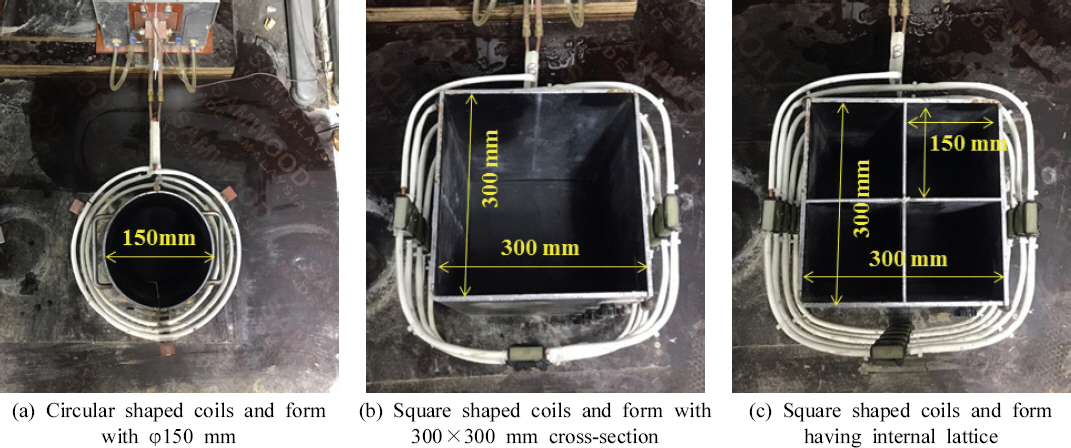
Fig. 1мқҳ лӘЁл“ кұ°н‘ём§‘мқҖ мң лҸ„м—җ мқҳн•ң л°ңм—ҙ нҡЁмңЁмқҙ мҡ°мҲҳн•ң мІ мһ¬м§ҲлЎң 4 mmмқҳ л‘җк»ҳлЎң м ңмһ‘мқҙ лҗҳм—Ҳмңјл©°, л°”лӢҘл©ҙмқҖ мң лҸ„ мһҗкё°мһҘмқҳ нқҗлҰ„мқ„ л°©н•ҙн•ҳм§Җ м•ҠлҸ„лЎқ н”ҢлқјмҠӨнӢұмңјлЎң м ңмһ‘лҗҳм—ҲлӢӨ. м„ н–үм—°кө¬(
Kim et al., 2020)мқҳ кІ°кіјлҘј м°ёкі н•ҳм—¬ мҳЁлҸ„분нҸ¬ л°Ҹ к· мқјлҸ„лҘј нҡЁмңЁм ҒмңјлЎң мң м§Җн• мҲҳ мһҲлҸ„лЎқ кұ°н‘ём§‘кіј мҪ”мқјмқҳ к°„кІ©мқҖ 35 mm, мҪ”мқјмқҖ 75 mmмқҳ л“ұк°„кІ©мңјлЎң м ңмһ‘лҗҳм—ҲлӢӨ. мң лҸ„к°Җм—ҙм–‘мғқ кіЎм„ м—ӯмӢң м„ н–үм—°кө¬(
Lee et al., 2019)мқҳ кІ°кіјлҘј м°ёкі н•ҳм—¬
Fig. 2мҷҖ к°ҷмқҙ мҙқ 15мӢңк°„мқҳ м–‘мғқмқ„ 진н–үн•ҳмҳҖлӢӨ. кө¬мІҙм ҒмңјлЎң м „ м–‘мғқ 3мӢңк°„, мөңкі мҳЁлҸ„ 70 В°C мң м§Җ 5мӢңк°„, нӣ„ м–‘мғқ 1.2мӢңк°„мқ„ м Ғмҡ©н•ҳмҳҖмңјл©°, мҳЁлҸ„ мғҒмҠ№мқҖ мӢңк°„лӢ№ 20 В°C мқҙн•ҳ, мҳЁлҸ„ н•ҳк°•мқҖ мӢңк°„лӢ№ 15 В°C мқҙн•ҳк°Җ лҗҳлҸ„лЎқ м„Өм •н•ҳмҳҖлӢӨ.
Fig.В 2
Temperature Variation During Curing
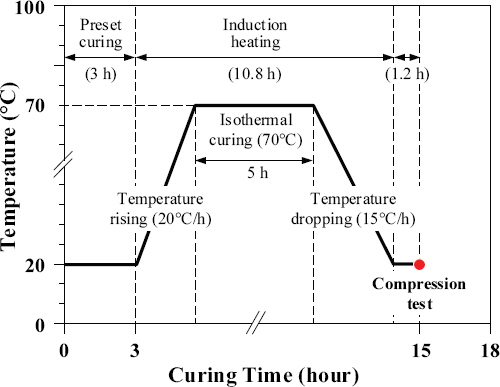
ліё м—°кө¬м—җм„ң мӮ¬мҡ©лҗң мң лҸ„к°Җм—ҙ мһҘм№ҳмқҳ кІҪмҡ°,
Fig. 3м—җм„ңмҷҖ к°ҷмқҙ мӢӨмӢңк°„мңјлЎң кі„мёЎлҗң мҳЁлҸ„лҘј л°”нғ•мңјлЎң Proportional Integral Derivative (PID) м ңм–ҙ кё°л°ҳмқҳ мҳЁлҸ„ мЎ°м Ҳкё°к°Җ
Fig. 2мқҳ л°ңм—ҙм–‘мғқ кіЎм„ мқ„ м •л°Җн•ҳкІҢ лӘЁмӮ¬н• мҲҳ мһҲлҸ„лЎқ м„Өкі„лҗҳм—ҲлӢӨ. мң лҸ„к°Җм—ҙ мһҘ비лҠ” мқҙлҸҷмқҳ нҺёмқҳлҘј мң„н•ҙ мҳЁлҸ„ м ңм–ҙкё°лҘј нҸ¬н•Ён•ң м „л ҘліҖнҷҳл¶ҖмҷҖ мҪ”мқјмқ„ нҸ¬н•Ён•ҳлҠ” к°Җм—ҙл¶Җмқҳ 분лҰ¬ нҳ•нғңлЎң м ңмһ‘мқҙ лҗҳм—Ҳмңјл©°, C/T Boxм—җ м—°кІ°лҗң мҪ”мқјмқҖ нғҲл¶Җм°©мқҙ к°ҖлҠҘн•ң кө¬мЎ°лЎң кө¬м„ұмқҙ лҗҳм–ҙмһҲлӢӨ. л”°лқјм„ң мҪ”мқјмқҳ ліҖкІҪмқ„ нҶөн•ҙ н•ҳлӮҳмқҳ м „л ҘліҖнҷҳмһҘм№ҳлЎң лӢӨм–‘н•ң нҳ•нғң л°Ҹ нҒ¬кё°мқҳ кұ°н‘ём§‘м—җ лҢҖн•ҙм„ң мң лҸ„к°Җм—ҙмқҙ к°ҖлҠҘн•ҳл©°, мҪ”мқјмқ„ лі‘л ¬лЎң м—°кІ°н• кІҪмҡ° м—¬лҹ¬ к°ңмқҳ кұ°н‘ём§‘м—җ лҢҖн•ң лҸҷмӢң к°Җм—ҙмқҙ к°ҖлҠҘн•ҳлҸ„лЎқ м„Өкі„лҗҳм—ҲлӢӨ(
Fig. 3). мқҙлҹ¬н•ң м „л ҘліҖнҷҳмһҘм№ҳлҠ” мөңлҢҖм¶ңл Ҙ 7 kWh, лҸҷмһ‘ мЈјнҢҢмҲҳ 40 kHzлЎң м„Өкі„лҗҳм—Ҳмңјл©°, C/T Boxм—җлҠ” кіө진 мәҗнҢЁмӢңн„° л°Ҹ м „лҘҳ мҰқнҸӯмқ„ мң„н•ң ліҖм••кё°к°Җ м„Өм№ҳлҗҳм–ҙ мһҲлӢӨ. мөңмў…м ҒмңјлЎң C/T BoxмҷҖ м—°кІ°лҗң мӣҢнӮ№ мҪ”мқјм—җ нқҗлҘҙлҠ” кі мЈјнҢҢ м „лҘҳм—җ мқҳн•ҙ л°ңмғқн•ң мһҗкё°мһҘмқҳ нқҗлҰ„мқ„ нҶөн•ҙ н”јк°Җм—ҙмІҙк°Җ л№„м ‘мҙүмӢқмңјлЎң к°Җм—ҙлҗҳлҠ” кө¬мЎ°лЎң лҗҳм–ҙмһҲлӢӨ.
Fig.В 3
Test Equipment for Heating Performance Test
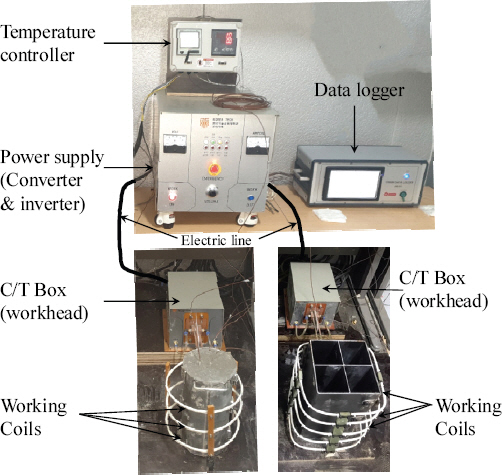
лӘЁл“ мӢӨн—ҳмқҖ лҸҷм Ҳкё° нҷҳкІҪмЎ°кұҙмқ„ лӘЁмӮ¬н•ҳкё° мң„н•ҳм—¬ 0 В°Cмқҳ н•ӯмҳЁмұ”лІ„м—җм„ң мҲҳн–үн•ҳмҳҖмңјл©°,
Fig. 1мқҳ 3мў…лҘҳ кұ°н‘ём§‘м—җ лҸҷмқјн•ң мҪҳнҒ¬лҰ¬нҠёлҘј нғҖм„Ө нӣ„ мҙқ 15мӢңк°„ лҸҷм•Ҳ мң лҸ„к°Җм—ҙ мһҘ비лҘј мқҙмҡ©н•ҳм—¬
Fig. 2мқҳ л°ңм—ҙм–‘мғқ кіЎм„ м—җ л”°лқј к°Җм—ҙмқ„ 진н–үн•ҳмҳҖлӢӨ. л°ңм—ҙм–‘мғқ кіЎм„ мқҖ м„ н–үм—°кө¬(
Lee et al., 2019)м—җм„ң мң лҸ„к°Җм—ҙ м–‘мғқм—җ мқҳн•ң мҙҲкё°к°•лҸ„ нҷ•ліҙм—җ к°ҖмһҘ нҡЁмңЁм Ғмқё кІғмңјлЎң нҷ•мқёлҗң мөңкі мҳЁлҸ„ 70 В°C-5мӢңк°„ мң м§ҖлЎң кІ°м •мқ„ н•ҳмҳҖлӢӨ. лҳҗн•ң лҸҷм Ҳкё° мҪҳнҒ¬лҰ¬нҠё нғҖм„Ө м§Ғнӣ„ лҸҷн•ҙлҘј л°©м§Җн•ҳкё° мң„н•ҳм—¬ мҙҲкё° 3мӢңк°„мқҳ м „ м–‘мғқ кө¬к°„м—җм„ңлҸ„ мң лҸ„к°Җм—ҙмқ„ нҶөн•ҙ 20 В°Cмқҳ мҳЁлҸ„лҘј мң м§Җн• мҲҳ мһҲлҸ„лЎқ м„Өм •н•ҳмҳҖлӢӨ. мң лҸ„к°Җм—ҙ кіјм •м—җм„ң кұ°н‘ём§‘ мў…лҘҳ л°Ҹ нҒ¬кё°лі„ лӮҙл¶Җ мҪҳнҒ¬лҰ¬нҠёмқҳ л°ңм—ҙ нҠ№м„ұмқ„ кұ°н‘ём§‘ лӮҙмёЎ л°Ҹ мҪҳнҒ¬лҰ¬нҠё лӢЁл©ҙ мӨ‘м•ҷл¶Җм—җ мӮҪмһ…лҗң м—ҙм „лҢҖ(Thermocouple)м—җм„ң кі„мёЎн•ң мҳЁлҸ„ лҚ°мқҙн„°лҘј нҶөн•ҙ нҸүк°Җн•ҳмҳҖлӢӨ. 추к°Җм ҒмңјлЎң мҪҳнҒ¬лҰ¬нҠё н‘ңл©ҙмқ„ м—ҙнҷ”мғҒ м№ҙл©”лқјлЎң мҙ¬мҳҒн•ҳм—¬ м—ҙм „лҢҖлЎң кі„мёЎн•ң кІ°кіј к°’мқ„ кІҖмҰқн•ҳмҳҖлӢӨ.
2.2 л°°н•© мў…лҘҳлі„ к°•лҸ„л°ңнҳ„ нҠ№м„ұ нҸүк°Җ
мҪҳнҒ¬лҰ¬нҠё л°°н•© мў…лҘҳм—җ л”°лҘё мң лҸ„к°Җм—ҙкё°л°ҳ л°ңм—ҙм–‘мғқ нҡЁмңЁм„ұмқ„ м–‘мғқ нӣ„ 압축강лҸ„ 비көҗлҘј нҶөн•ҙ нҸүк°Җн•ҳмҳҖлӢӨ. мқҙлҘј мң„н•ҙ
Table 1кіј к°ҷмқҙ л¬ј/мӢңл©ҳнҠё 비(W/C)к°Җ к°Ғк°Ғ 38% л°Ҹ 44%мқё л‘җ мў…лҘҳмқҳ ліҙнҶөмҪҳнҒ¬лҰ¬нҠё л°°н•©мқҙ мӮ¬мҡ©лҗҳм—ҲлӢӨ. W/C38 л°°н•©мқҖ нҳ„мһҘм—җм„ң көҗк°Ғмҡ© н•ңмӨ‘ мҪҳнҒ¬лҰ¬нҠёлЎң мӮ¬мҡ©мқҙ лҗҳкі мһҲлҠ” м„Өкі„кё°мӨҖк°•лҸ„ м•Ҫ 35 MPaмқҳ л°°н•©мқҙл©°, W/C44 л°°н•©мқҖ нҳ„мһҘм—җм„ң көҗк°Ғ, м•”кұ°, көҗлҢҖ л“ұм—җ мӮ¬мҡ©мқҙ лҗҳкі мһҲмңјл©°, мқјл°ҳм Ғмқё кі„м Ҳм—җ м Ғн•©н•ң м„Өкі„кё°мӨҖк°•лҸ„ м•Ҫ 24 MPaмқҳ л°°н•©мқҙлӢӨ.
TableВ 1
|
Mix |
W/C (%) |
S/a (%) |
Unit Weight (kg/m3) |
SP (%) |
|
W |
C |
S |
G |
|
W/C38 |
38.3 |
47.9 |
176 |
460 |
800 |
894 |
0.75-0.9 |
|
W/C44 |
43.9 |
49.2 |
160 |
364 |
879 |
914 |
0.65-0.8 |
Table 1мқҳ л°°н•©м—җ мӮ¬мҡ©лҗң мһ¬лЈҢмқҳ л¬јлҰ¬м Ғ нҠ№м§•мқҖ лӢӨмқҢкіј к°ҷлӢӨ.
(1) 1мў… ліҙнҶө нҸ¬нӢҖлһңл“ң мӢңл©ҳнҠё: л°ҖлҸ„ 3.15 g/cm3, 비н‘ңл©ҙм Ғ 3,000 cm2/g, нҸүк· мһ…кІҪнҒ¬кё° 13.2 Ојm)
(2) көөмқҖкіЁмһ¬(мҮ„м„қ): мөңлҢҖм№ҳмҲҳ 25 mm, л°ҖлҸ„ 2.67 g/cm3, мЎ°лҰҪлҘ 6.12
(3) мһ”кіЁмһ¬(мһҗм—°мӮ¬): л°ҖлҸ„ 2.56 g/cm3, мЎ°лҰҪлҘ 2.99
(4) нҳјнҷ”м ң: нҸҙлҰ¬м№ҙліёмӮ°кі„ көӯлӮҙмӮ° кі м„ұлҠҘ к°җмҲҳм ң
к°Ғк°Ғ W/C38 л°Ҹ W/C44 л°°н•©м—җ мһҲм–ҙ лӘ©н‘ң мҠ¬лҹјн”„м—җ лҸ„лӢ¬н•ҳкё° мң„н•ҙ кі м„ұлҠҘ к°җмҲҳм ңк°Җ м•Ҫ 0.75~0.9%, 0.65~0.8% л§ҢнҒј мӮ¬мҡ©лҗҳм—Ҳмңјл©°, л¬ј/мӢңл©ҳнҠё 비к°Җ к°җмҶҢн• мҲҳлЎқ лҚ” л§ҺмқҖ м–‘мқҳ кі м„ұлҠҘ к°җмҲҳм ңк°Җ нҳјмһ…лҗҳм—ҲлӢӨ. көім§Җм•ҠмқҖ мҪҳнҒ¬лҰ¬нҠёмқҳ л¬јм„ұм—җм„ң KS F 2402 (2017)м—җ л”°лқј мҠ¬лҹјн”„ мӢңн—ҳмқ„ мҲҳн–үн•ҳмҳҖмңјл©°, л‘җ л°°н•© лӘЁл‘җ нҸүк· 120 mm м •лҸ„мқҳ мҠ¬лҹјн”„лҘј лӮҳнғҖлӮҙм—ҲлӢӨ.
мң лҸ„к°Җм—ҙ м–‘мғқкіјм •мқҖ м•һм„ 2.1м Ҳмқҳ кұ°н‘ём§‘ л°ңм—ҙнҠ№м„ұ нҸүк°ҖмҷҖ мң мӮ¬н•ҳл©°, ліё мӢӨн—ҳм—җм„ңлҠ” 압축강лҸ„ нҸүк°ҖлҘј мң„н•ҙ
Fig. 1(a)мҷҖ к°ҷмқҖ мІ мһ¬м§Ҳмқҳ
ПҶ150 вЁү 300 mm кұ°н‘ём§‘м—җ м„ңлЎң лӢӨлҘё л°°н•©мқҳ мҪҳнҒ¬лҰ¬нҠё(W/C38, W/C44)лҘј к°Ғк°Ғ 2к°ңм”© нғҖм„Өн•ҳм—¬ 15мӢңк°„ лҸҷм•Ҳ 0 В°Cмқҳ мұ”лІ„м—җм„ң
Fig. 2мқҳ мҳЁлҸ„кіЎм„ м—җ л”°лқј мң лҸ„к°Җм—ҙм–‘мғқмқ„ 진н–үн•ҳмҳҖлӢӨ(IHC). лҳҗн•ң м–‘мғқмЎ°кұҙм—җ л”°лҘё к°•лҸ„ 비көҗлҘј мң„н•ҙ лҸҷмқјн•ң нҒ¬кё°мқҳ кұ°н‘ём§‘м—җ лҸҷмқј л°°н•©мқҳ мҪҳнҒ¬лҰ¬нҠёлҘј нғҖм„Ө нӣ„, к°Ғк°Ғ 3к°ңмқҳ мӢңн—ҳмІҙлҘј мң лҸ„к°Җм—ҙмӢңн—ҳмқҙ 진н–үлҗҳлҠ” 0 В°C мұ”лІ„(LTC) л°Ҹ мғҒмҳЁмұ”лІ„(MTC)м—җ л„Јм–ҙ 15мӢңк°„лҸҷм•Ҳ м ҖмҳЁ л°Ҹ мғҒмҳЁм—җм„ң м–‘мғқн•ҳмҳҖлӢӨ. лӘЁл“ мӢңн—ҳмІҙлҠ” 15мӢңк°„ м–‘мғқ нӣ„ KS F 2405 (2010)м—җ мӨҖн•ҳм—¬ 압축강лҸ„ мӢңн—ҳмқ„ мҲҳн–үн•ҳм—¬ к·ё к°•лҸ„лҘј 비көҗн•ҳмҳҖлӢӨ.
2.3 мң лҸ„к°Җм—ҙ мӢң м „мһҗнҢҢ мң н•ҙм„ұ нҸүк°Җ
мң лҸ„к°Җм—ҙмқҖ к°Җм—ҙмҪ”мқјм—җ нқҗлҘҙлҠ” м „лҘҳм—җ мқҳн•ҙм„ң л°ңмғқлҗҳлҠ” мһҗкё°мһҘмңјлЎң н”јк°Җм—ҙмІҙлҘј к°Җм—ҙн•ҳлҠ” л°©мӢқмңјлЎң мҪ”мқј мЈјліҖм—җлҠ” н•ӯмғҒ мһҗкё°мһҘмқҙ мғқм„ұлҗңлӢӨ. л”°лқјм„ң мң лҸ„к°Җм—ҙмқҳ мӮ¬мҡ©м—җ мһҲм–ҙ м „мһҗнҢҢм—җ мқҳн•ң мқёмІҙ мң н•ҙм„ұ л¬ём ңк°Җ н•Ёк»ҳ кұ°лЎ мқҙ лҗҳкі мһҲлӢӨ. нҳ„мһ¬ к°Җм •м—җм„ңлҸ„ мқёлҚ•м…ҳ л Ҳмқём§ҖлҘј мЎ°лҰ¬лҸ„кө¬лЎң м•Ҳм „н•ҳкІҢ мӮ¬мҡ©н•ҳкі мһҲм§Җл§Ң, мҪҳнҒ¬лҰ¬нҠё м–‘мғқ мӢң н•„мҡ”н•ң мһҘ비лҠ” кұҙм„ӨкіөмӮ¬мқҳ нҠ№м„ұмқ„ кі л Өн• л•Ң к°Җм •мҡ© мқёлҚ•м…ҳм—җ 비н•ҙ к°Җм—ҙл©ҙм Ғкіј м¶ңл Ҙм „л Ҙлҹүмқҙ нҒ¬кІҢ лҗңлӢӨ. л”°лқјм„ң мң лҸ„к°Җм—ҙ мӢң л°ңмғқн•ҳлҠ” мһҗкё°мһҘмқҙ мһ‘м—…мһҗмқҳ кұҙк°•м—җ лҜём№ҳлҠ” мң н•ҙм„ұмқ„ кІҖнҶ н• н•„мҡ”к°Җ мһҲмңјл©°, мқҙлҠ” м „мһҗнҢҢ м Ғн•©м„ұ(Electro Magnetic Compatibility, EMC) кё°мӨҖ(
RRA, 2019)мқ„ л§ҢмЎұн•ҙм•ј н•ңлӢӨ.
мқҙлҘј мң„н•ҙ
Fig. 4(a)мқҳ м „мһҗнҢҢ мёЎм •кё°кё°(EHP-200)лҘј нҷңмҡ©н•ҳм—¬
Fig. 4(b)мҷҖ к°ҷмқҙ мң лҸ„к°Җм—ҙ мӨ‘ мһҗмҶҚл°ҖлҸ„лҘј мёЎм •н•ҳмҳҖлӢӨ. м „мһҗнҢҢ мёЎм • мһҘ비лҠ” мң лҸ„к°Җм—ҙ мҪ”мқјлЎңл¶Җн„° 300 mm л§ҢнҒј мқҙкІ©н•ҳм—¬, к°Ғ л°©н–Ҙмқҳ 100 cm
2 л©ҙм Ғм—җм„ң мёЎм •н•ң нҸүк· мқ„ кө¬н•ңлӢӨ. м „мһҗнҢҢ мёЎм • мӢң мң лҸ„к°Җм—ҙ мһҘ비лҠ” мӢӨн—ҳмІҙлҘј м•Ҫ 80 В°C м •лҸ„мқҳ кі мҳЁмңјлЎң к°Җм—ҙн•ҳлҠ” мғҒнғңлЎң м„Өм •н•ҳмҳҖмңјл©°, мқҙл•Ң м „л ҘліҖнҷҳмһҘм№ҳмқҳ м¶ңл ҘмқҖ 140 V, 4 AлҘј лӮҳнғҖлӮҙм—ҲлӢӨ.
Fig.В 4
Test Setup and Equipment for Measuring Magnetic Flux Density
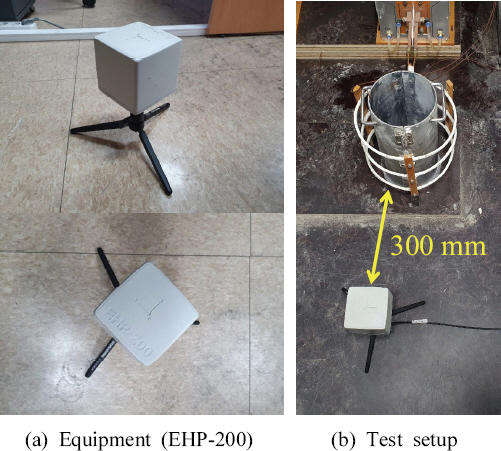
3. мӢӨн—ҳкІ°кіј л°Ҹ 분м„қ
3.1 кұ°н‘ём§‘ нҒ¬кё° л°Ҹ нҳ•мғҒм—җ л”°лҘё л°ңм—ҙнҠ№м„ұ нҸүк°Җ
Fig. 1м—җм„ң м„ӨлӘ…н•ң нҒ¬кё° л°Ҹ нҳ•мғҒмқҙ лӢӨлҘё 3мў…лҘҳмқҳ кұ°н‘ём§‘м—җ мҪҳнҒ¬лҰ¬нҠёлҘј нғҖм„Өн•ң нӣ„ 15мӢңк°„мқҳ мң лҸ„к°Җм—ҙ м–‘мғқмқ„ мҲҳн–үн•ҳл©ҙм„ң мёЎм •н•ң мҳЁлҸ„мқҙл Ҙ кІ°кіјлҘј
Fig. 5м—җ лӮҳнғҖлӮҙм—ҲлӢӨ.
Fig. 5(a)лҠ” м§ҖлҰ„ 150 mmмқҳ мӣҗнҳ• мІ мһ¬ кұ°н‘ём§‘мқ„ мӮ¬мҡ©н•ң кІҪмҡ°мқҳ мӢңн—ҳкІ°кіјмқҙлӢӨ. к·ёлҰјм—җм„ң вҖңSMвҖқмқҳ кІҪмҡ° кұ°н‘ём§‘ лӮҙмёЎм—җм„ң мҪҳнҒ¬лҰ¬нҠёмҷҖ м ‘н•ҳлҠ” л¶Җ분мқҳ мҳЁлҸ„мқҙл©°, вҖңCMвҖқмқҖ м§ҖлҰ„ 150 mmмқё мҪҳнҒ¬лҰ¬нҠё кіөмӢңмІҙ мӨ‘мӢ¬м—җм„ңмқҳ мҳЁлҸ„ кі„мёЎ кІ°кіјмқҙлӢӨ. л‘җ кІҪмҡ° лӘЁл‘җ, кёёмқҙл°©н–ҘмңјлЎңлҠ” кіөмӢңмІҙ лҶ’мқҙмқҳ м Ҳл°ҳм—җ н•ҙлӢ№н•ҳлҠ” мң„м№ҳмқҳ мҳЁлҸ„лҘј мқҳлҜён•ңлӢӨ.
Fig.В 5
Temperatures Measured during Induction Heat Curing
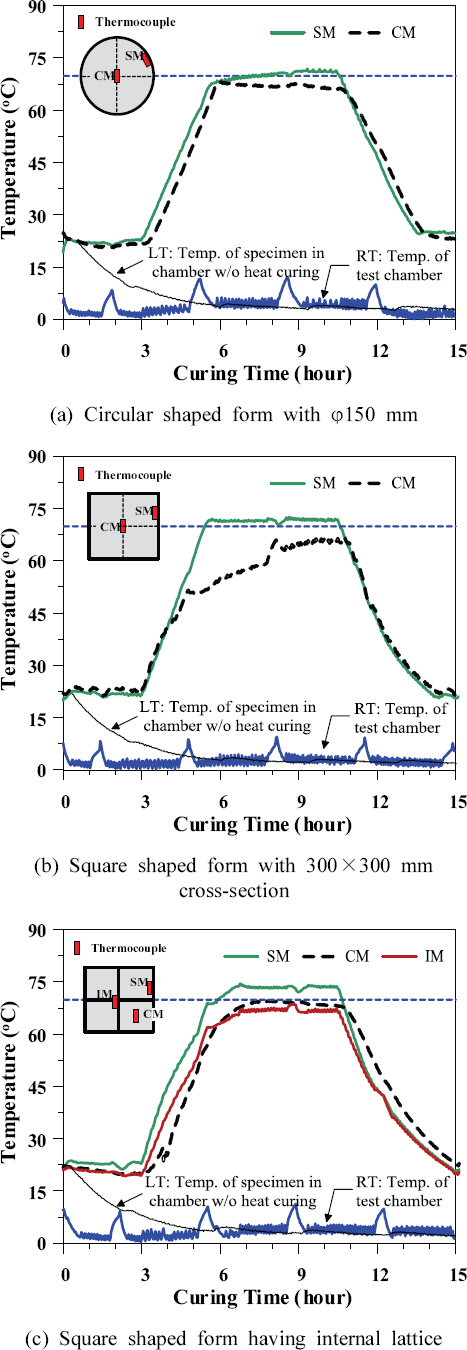
мҙҲкё° м „ м–‘мғқ кө¬к°„м—җм„ңлҠ” 0 В°C мұ”лІ„ лӮҙм—җм„ң мғҒмҳЁкіј 비мҠ·н•ң мҲҳмӨҖмқ„ мң м§Җн•ҳкё° мң„н•ҙ мөңмҶҢмқҳ м¶ңл ҘмңјлЎң мң лҸ„к°Җм—ҙкё°к°Җ мһ‘лҸҷн•ҳл©° мҪҳнҒ¬лҰ¬нҠё лӮҙл¶ҖмҷҖ кұ°н‘ём§‘мқҳ мҳЁлҸ„к°Җ 비мҠ·н•ҳкІҢ мң м§ҖлҗҳлҠ” кІғмқ„ нҷ•мқён• мҲҳ мһҲлӢӨ. мҳЁлҸ„ мғҒмҠ№кө¬к°„м—җм„ңлҠ” ліёкІ©м ҒмңјлЎң мң лҸ„к°Җм—ҙм—җ мқҳн•ҙ кұ°н‘ём§‘мқҳ мҳЁлҸ„к°Җ мғҒмҠ№н•ҳкІҢ лҗҳм–ҙ, м§Ғм ‘м ҒмңјлЎң к°Җм—ҙмқҙ лҗҳлҠ” кұ°н‘ём§‘мқҳ мҳЁлҸ„ мғҒмҠ№мҶҚлҸ„к°Җ мҪҳнҒ¬лҰ¬нҠё лӮҙл¶Җмқҳ мҳЁлҸ„ мғҒмҠ№мҶҚлҸ„ ліҙлӢӨ л№ лҘё кІғмқ„ м•Ң мҲҳ мһҲлӢӨ. мқҙлҹ¬н•ң кІҪн–ҘмқҖ мөңлҢҖмҳЁлҸ„ мң м§Җк°Җ лҒқлӮҳлҠ” мӢңм җ(м•Ҫ 10:30 h)м—җм„ң м—ӯм „мқҙ лҗҳм–ҙ мҳЁлҸ„н•ҳк°• кө¬к°„м—җм„ңлҠ” кұ°н‘ём§‘мқҳ мҳЁлҸ„ н•ҳк°•мқҙ мҪҳнҒ¬лҰ¬нҠё мӨ‘мӢ¬л¶Җ мҳЁлҸ„ н•ҳк°•ліҙлӢӨ лӢӨмҶҢ л№ лҘё кІғмқ„ м•Ң мҲҳ мһҲлӢӨ. н•ңнҺё, мөңкі мҳЁлҸ„ мң м§Җкө¬к°„м—җм„ңлҸ„ мқјм •н•ң мҳЁлҸ„ мң м§ҖлҘј мң„н•ҙ мөңмҶҢн•ңмқҳ м¶ңл Ҙмқҙ л°ңмғқлҗҳм–ҙ кұ°н‘ём§‘мқҳ к°Җм—ҙ/비к°Җм—ҙмқҙ л°ҳліөмқҙ лҗҳл©°, мқҙм—җ л”°лқј м§Ғм ‘м ҒмңјлЎң к°Җм—ҙмқҙ лҗҳлҠ” кұ°н‘ём§‘мқҳ мҳЁлҸ„к°Җ мҪҳнҒ¬лҰ¬нҠё мӨ‘мӢ¬л¶Җ мҳЁлҸ„ліҙлӢӨ м•Ҫ 0~4 В°C м •лҸ„ лҶ’мқҖ кІғмқ„ нҷ•мқён• мҲҳ мһҲлӢӨ. к·ёлҹ¬лӮҳ мқҙлҹ¬н•ң лҜём„ён•ң мҳЁлҸ„мқҳ м°ЁмқҙлҠ” мҷёл¶ҖнҷҳкІҪ л°Ҹ мҳЁлҸ„ м ңм–ҙкіјм •м—җм„ңмқҳ мҳӨм°ЁлҘј кі л Өн• л•Ң л¬ҙмӢңн• л§Ңн•ң кІ°кіјлқјкі н• мҲҳ мһҲлӢӨ. л”°лқјм„ң м„ н–үм—°кө¬(
Lee et al., 2019)м—җм„ңлҸ„ нҷ•мқёлҗң л°”мҷҖ к°ҷмқҙ м§ҖлҰ„ 150 mmмқҳ мӣҗнҳ• мІ мһ¬ кұ°н‘ём§‘мқ„ мӮ¬мҡ©н•ң кІҪмҡ°, мң лҸ„м—җ мқҳн•ҙ к°Җм—ҙмқҙ лҗҳлҠ” кұ°н‘ём§‘ л°Ҹ лӮҙл¶Җ мҪҳнҒ¬лҰ¬нҠёмқҳ мҳЁлҸ„нҺём°Ёк°Җ нҒ¬м§Җ м•Ҡмңјл©° кІ°кіјм ҒмңјлЎң мҪҳнҒ¬лҰ¬нҠё м „лӢЁл©ҙмқ„ кіЁкі лЈЁ л°ңм—ҙмӢңнӮ¬ мҲҳ мһҲмқҢмқ„ нҷ•мқён• мҲҳ мһҲлӢӨ.
н•ңнҺё
Fig. 5(b)лҠ” лӢЁл©ҙмқҙ 300 вЁү 300 mmмқё м§ҒмӮ¬к°Ғнҳ• кұ°н‘ём§‘ мңјлЎң,
Fig. 5(a)мқҳ мӣҗнҳ• кұ°н‘ём§‘кіј 비көҗн•ҳм—¬ кұ°н‘ём§‘ н‘ңл©ҙм—җм„ң мҪҳнҒ¬лҰ¬нҠё мӨ‘мӢ¬л¶Җк№Ңм§Җмқҳ мөңлӢЁкұ°лҰ¬к°Җ м•Ҫ 2л°° м •лҸ„ мҰқк°Җлҗң кІҪмҡ°м—җ лҢҖн•ң л°ңм—ҙм–‘мғқ мҳЁлҸ„мқҙл Ҙ кІ°кіјмқҙлӢӨ. м „ м–‘мғқ кө¬к°„ л°Ҹ мҳЁлҸ„ мғҒмҠ№кө¬к°„ мҙҲкё°м—җлҠ” кұ°н‘ём§‘кіј мҪҳнҒ¬лҰ¬нҠё лӮҙл¶Җмқҳ мҳЁлҸ„к°Җ 비мҠ·н•ң кІҪн–Ҙмқ„ ліҙмқҙм§Җл§Ң, мқҙнӣ„ мҪҳнҒ¬лҰ¬нҠё лӮҙл¶Җ мҳЁлҸ„ мғҒмҠ№ мҶҚлҸ„лҠ” кёүкІ©нһҲ к°җмҶҢн•ҳм—¬ мң лҸ„к°Җм—ҙм—җ мқҳн•ң л°ңм—ҙм–‘мғқм—җм„ң мөңлҢҖмҳЁлҸ„ мң м§Җкё°к°„мқҙ лҒқлӮҳлҠ” мӢңм җ(10:30 h)м—җм„ңлҸ„ лӘ©н‘ң мөңлҢҖмҳЁлҸ„мқё 70 В°Cм—җ лҸ„лӢ¬н•ҳм§Җ лӘ»н•ҳлҠ” кІғмқ„ нҷ•мқён• мҲҳ мһҲлӢӨ. мөңлҢҖмҳЁлҸ„ мң м§Җкө¬к°„м—җм„ң кұ°н‘ём§‘кіј мҪҳнҒ¬лҰ¬нҠё мӨ‘мӢ¬л¶Җмқҳ мҳЁлҸ„ м°ЁмқҙлҠ” м•Ҫ 5~20 В°CлЎң мҪҳнҒ¬лҰ¬нҠё лӢЁл©ҙм Ғ мҰқк°Җм—җ л”°лқј кұ°н‘ём§‘ мң лҸ„к°Җм—ҙмқ„ нҶөн•ң мҪҳнҒ¬лҰ¬нҠё м „лӢЁл©ҙмқҳ к· мқјн•ң л°ңм—ҙм„ұлҠҘмқ„ нҷ•ліҙн•ҳкё°м—җ н•ңкі„к°Җ мһҲмқҢмқ„ нҷ•мқён•ҳмҳҖлӢӨ.
мғҒкё°мқҳ лӢЁл©ҙмҰқк°Җм—җ л”°лҘё мҪҳнҒ¬лҰ¬нҠё м „лӢЁл©ҙ л°ңм—ҙм„ұлҠҘ нҷ•ліҙмқҳ м–ҙл ӨмӣҖмқ„ н•ҙкІ°н•ҳкі мһҗ, кұ°н‘ём§‘ лӮҙл¶Җ лӢЁл©ҙмқҳ к°ҖмҡҙлҚ°м—җ 추к°ҖлЎң мң лҸ„ л°Ҹ м—ҙм „лӢ¬мқҙ к°ҖлҠҘн•ң мІ мһ¬м§Ҳмқҳ лӮҙл¶Җ м№ёл§үмқҙлҘј 추к°Җн•ң кұ°н‘ём§‘м—җ мҪҳнҒ¬лҰ¬нҠё нғҖм„Өн•ң мқҙнӣ„ мң лҸ„к°Җм—ҙ м–‘мғқ мӨ‘мқҳ мҳЁлҸ„лҘј кі„мёЎн•ҳм—¬
Fig. 5(c)м—җ лӮҳнғҖлӮҙм—ҲлӢӨ. мң лҸ„м—җ мқҳн•ҙ м§Ғм ‘м ҒмңјлЎң к°Җм—ҙлҗҳлҠ” мҷёл¶Җ кұ°н‘ём§‘кіј 비көҗн•ҳм—¬ мҪҳнҒ¬лҰ¬нҠё мӨ‘м•ҷл¶Җ л°Ҹ лӮҙл¶Җ мІ мһ¬ м№ёл§үмқҙ л¶Җ분мқҳ мҳЁлҸ„к°Җ лӢӨмҶҢ лӮ®кІҢ мёЎм •мқҙ лҗҳм—ҲмңјлӮҳ, мҳЁлҸ„ м°ЁмқҙлҠ” м•Ҫ 5 В°C лҜёл§ҢмңјлЎң нҷ•мқёмқҙ лҗҳм—ҲлӢӨ. мқҙлҹ¬н•ң кІ°кіјлҠ” мҪҳнҒ¬лҰ¬нҠё лӢЁл©ҙм Ғмқҙ мҰқк°Җн•ҳлҠ” кІҪмҡ°м—җлҸ„ лӮҙл¶Җм—җ мң лҸ„ л°Ҹ м—ҙм „лӢ¬мқҙ к°ҖлҠҘн•ң мһ¬лЈҢлҘј л„Јм–ҙмЈјлҠ” кІҪмҡ° мң лҸ„к°Җм—ҙм—җ мқҳн•ң кұ°н‘ём§‘ лӮҙл¶Җ мҪҳнҒ¬лҰ¬нҠёмқҳ л°ңм—ҙм„ұлҠҘмқ„ н–ҘмғҒ мӢңнӮ¬ мҲҳ мһҲмқҢмқ„ мӢңмӮ¬н•ҳлҠ” кІ°кіјмқҙлӢӨ. н•ңнҺё, мқҙлҹ¬н•ң нҡЁкіјлҠ”
Fig. 6мқҳ мҪҳнҒ¬лҰ¬нҠё н‘ңл©ҙм—җ лҢҖн•ң м—ҙнҷ”мғҒ м№ҙл©”лқј мҙ¬мҳҒ кІ°кіј(
Fig. 1(c) лӢЁл©ҙ)лҘј нҶөн•ҙм„ңлҸ„ нҷ•мқён• мҲҳ мһҲлӢӨ. мөңкі мҳЁлҸ„ кө¬к°„м—җм„ң м—ҙнҷ”мғҒ м№ҙл©”лқјлҘј мқҙмҡ©н•ҙ мҪҳнҒ¬лҰ¬нҠё н‘ңл©ҙ мҳЁлҸ„лҘј нҷ•мқён•ң кІ°кіј, мҳЁлҸ„к°Җ к°ҖмһҘ лҶ’мқҖ мҷёл¶Җ кұ°н‘ём§‘(м•Ҫ 55 В°C)кіј 비көҗн•ҳм—¬ лӮҙл¶Җ мҪҳнҒ¬лҰ¬нҠёмқҳ мҳЁлҸ„(м•Ҫ 49 В°C) м°Ёмқҙк°Җ м•Ҫ 6 В°C м •лҸ„лЎң м—ҙм „лҢҖлҘј нҶөн•ҙ кі„мёЎн•ң лӮҙмҷёл¶Җ мҳЁлҸ„м°Ёмқҙ(м•Ҫ 5 В°C лҜёл§Ң)мҷҖ 비мҠ·н•ң кІ°кіјлҘј лӮҳнғҖлӮҙм—Ҳмңјл©°, мҪҳнҒ¬лҰ¬нҠё м „лӢЁл©ҙм—җм„ң мҳЁлҸ„нҺём°Ёк°Җ нҒ¬м§Җ м•ҠмқҢмқ„ нҷ•мқён• мҲҳ мһҲлӢӨ. м—¬кё°м„ң, м—ҙнҷ”мғҒ м№ҙл©”лқјлЎң нҷ•мқён•ң кұ°н‘ём§‘ л°Ҹ мҪҳнҒ¬лҰ¬нҠёмқҳ мҳЁлҸ„(м•Ҫ 47~55 В°C)к°Җ м—ҙм „лҢҖ кі„мёЎкІ°кіј(м•Ҫ 67~73 В°C)ліҙлӢӨ лӢӨмҶҢ лӮ®мқҖ мқҙмң лҠ” м—ҙм „лҢҖмқҳ кІҪмҡ° кіөмӢңмІҙмқҳ кёёмқҙл°©н–Ҙ к°ҖмҡҙлҚ° мң„м№ҳм—җм„ң мҪҳнҒ¬лҰ¬нҠё л°Ҹ кұ°н‘ём§‘мқҳ лӮҙл¶Җ мҳЁлҸ„лҘј кі„мёЎн•ң л°ҳл©ҙ, м—ҙнҷ”мғҒ м№ҙл©”лқјмқҳ кІҪмҡ° 0Лҡмқҳ лҢҖкё°мҷҖ м ‘н•ҳкі мһҲлҠ” мҪҳнҒ¬лҰ¬нҠё л°Ҹ кұ°н‘ём§‘мқҳ н‘ңл©ҙм—җ лҢҖн•ң мҙ¬мҳҒ кІ°кіјмқҙкё° л•Ңл¬ёмқё кІғмңјлЎң нҢҗлӢЁлҗңлӢӨ.
Fig.В 6
Temperature Variations of Induction Heat Cured Concrete Surface
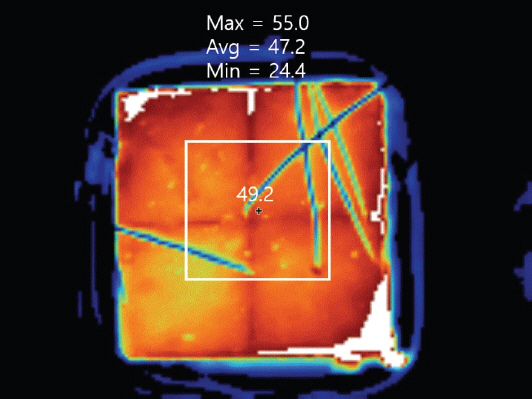
мқҙмғҒмқҳ кІ°кіјлҘј мў…н•©н•ҙ ліј л•Ң, кұ°н‘ём§‘ мң лҸ„м—җ мқҳн•ң мҪҳнҒ¬лҰ¬нҠё к°Җм—ҙм–‘мғқм—җ мһҲм–ҙм„ң м „лӢЁл©ҙмқҳ кі лҘё мҳЁлҸ„분нҸ¬ м„ұлҠҘмқҖ мҪҳнҒ¬лҰ¬нҠё л°Ҹ кұ°н‘ём§‘мқҳ лӢЁл©ҙм Ғмқҙ мҰқк°Җ н• мҲҳлЎқ к°җмҶҢн•ҳлҠ” кІғмңјлЎң лӮҳнғҖлӮ¬мңјл©°, мқҙлҹ¬н•ң л¬ём ңлҠ” лӢЁл©ҙ лӮҙл¶Җм—җ 추к°ҖлЎң мң лҸ„ л°Ҹ м—ҙм „лӢ¬мқҙ к°ҖлҠҘн•ң мһ¬лЈҢлҘј л„Јм–ҙмӨҢмңјлЎң мқён•ҙ мқјм •л¶Җ분 ліҙмҷ„мқҙ к°ҖлҠҘн•Ёмқ„ нҷ•мқён•ҳмҳҖлӢӨ.
3.2 мң лҸ„к°Җм—ҙ мҪҳнҒ¬лҰ¬нҠёмқҳ 압축강лҸ„ кІ°кіј
Table 2м—җ л°°н•© мў…лҘҳ л°Ҹ м–‘мғқ л°©лІ•лі„ 15мӢңк°„ 압축강лҸ„ мӢңн—ҳкІ°кіјлҘј лӮҳнғҖлӮҙм—Ҳмңјл©°, к°Ғ л°°н•©м—җ л”°лҘё к°•лҸ„м°ЁмқҙлҘј кі л Өн•ҳкё° мң„н•ҙ мғҒмҳЁм–‘мғқ мҪҳнҒ¬лҰ¬нҠёмқҳ к°•лҸ„м—җ лҢҖн•ң 비мңЁлҸ„ н•Ёк»ҳ нҸүк°Җн•ҳмҳҖлӢӨ. н•ңнҺё, м–‘мғқ л°©лІ•м—җ кҙҖкі„м—Ҷмқҙ W/C38 л°Ҹ W/C44 л°°н•©мқҳ 28мһ¬л № 압축강лҸ„лҠ” м•Ҫ 42 MPa, 35 MPaмқ„ мғҒнҡҢн•ҳм—¬ лӘ©н‘ңк°•лҸ„лҘј нҷ•ліҙн•ҳмҳҖлӢӨ.
TableВ 2
Compressive Strength Results at 15 h
|
Specimen |
MTC |
LTC |
IHC |
|
fc (MPa) |
fc (MPa) |
fc/fc(MTC) (%)*
|
fc (MPa) |
fc/fc(MTC) (%)*
|
|
W/C38 |
14.8 |
0.3 |
2 |
25.7 |
173 |
|
W/C44 |
12.1 |
0.2 |
2 |
16.2 |
135 |
л¬ј/мӢңл©ҳнҠё 비к°Җ 38%м—җм„ң 44%лЎң мҰқк°Җн•Ём—җ л”°лқј 15мӢңк°„ мғҒмҳЁ м–‘мғқлҗң MTC мӢңн—ҳмІҙмқҳ нҸүк· м••м¶•к°•лҸ„лҠ” 14.8 MPaм—җм„ң 12.1 MPaлЎң м•Ҫ 18%л§ҢнҒј к°җмҶҢн•ҳлҠ” кІғмқ„ нҷ•мқё н• мҲҳ мһҲм—ҲлӢӨ. мқҙлҠ” л¬ј/мӢңл©ҳнҠёл№„мҷҖ мҪҳнҒ¬лҰ¬нҠёмқҳ 압축강лҸ„к°Җ л°ҳ비лЎҖ кҙҖкі„лҘј ліҙмқҙлҠ” мқјл°ҳм Ғмқё нҳ„мғҒмңјлЎң нҷ•мқёлҗңлӢӨ(
Neville, 1995;
Mehta and Monteiro, 2006). н•ңнҺё, м„ н–үм—°кө¬(
Lee et al., 2019)мқҳ кІ°кіјмҷҖ л§Ҳм°¬к°Җм§ҖлЎң, лі„лҸ„мқҳ мқёмң„м Ғмқё м–‘мғқкіјм • м—Ҷмқҙ 0 В°Cмқҳ мұ”лІ„м—җм„ң м–‘мғқлҗң LTC мӢңн—ҳмІҙмқҳ кІҪмҡ° 15мӢңк°„ 압축강лҸ„лҠ” W/C38 л°Ҹ W/C44л°°н•©м—җм„ң к°Ғк°Ғ 0.3 MPa л°Ҹ 0.2 MPaмқҙл©°, л‘җ л°°н•© лӘЁл‘җ лҸҷмқјмһ¬л №мқҳ мғҒмҳЁм–‘мғқ мҪҳнҒ¬лҰ¬нҠёмқҳ к°•лҸ„ лҢҖ비 м•Ҫ 2% мҲҳмӨҖмңјлЎң 압축강лҸ„ мӢңн—ҳ мһҗмІҙк°Җ кұ°мқҳ л¶Ҳк°ҖлҠҘн•ң мҲҳмӨҖмңјлЎң к°•лҸ„л°ңнҳ„мқҙ 진н–үлҗҳм§Җ м•Ҡм•ҳлӢӨ. л”°лқјм„ң
Lee et al. (2019)мқҖ м„ н–үм—°кө¬м—җм„ң, мҪҳнҒ¬лҰ¬нҠё нғҖм„Ө нӣ„ к·№ мҙҲкё°м—җлҠ” вҖ“10 В°C мқҙн•ҳ лҳҗлҠ” мҳҒн•ҳмқҳ лҸҷкІ°мҳЁлҸ„ мқҙн•ҳк°Җ м•„лӢҢ кІҪмҡ°м—җлҸ„ м•Ҫ 5 В°C мқҙн•ҳмқҳ м ҖмҳЁм—җм„ңлҠ” мҪҳнҒ¬лҰ¬нҠё мЎ°кё°к°•лҸ„ л°ңнҳ„мқҙ кұ°мқҳ мқҙлЈЁм–ҙм§Җм§Җ м•ҠлҠ” кІғмңјлЎң м„ӨлӘ…н•ҳмҳҖлӢӨ.
н•ңнҺё, 0 В°Cмқҳ н•ӯмҳЁмұ”лІ„м—җм„ң мң лҸ„м—җ мқҳн•ң кұ°н‘ём§‘ к°Җм—ҙкё°лІ•мңјлЎң 15мӢңк°„ м–‘мғқн•ң IHC мӢңн—ҳмІҙмқҳ кІҪмҡ°, W/C38 л°Ҹ W/C44 л°°н•©м—җм„ң к°Ғк°Ғ 압축강лҸ„ 25.7 MPa л°Ҹ 16.2 MPaмқҳ кІ°кіјлҘј лӮҳнғҖлӮҙм—ҲлӢӨ. мқҙлҹ¬н•ң кІ°кіјлҠ” к°Ғк°Ғ лҸҷмқјмһ¬л № мғҒмҳЁм–‘мғқ мӢңн—ҳмІҙ к°•лҸ„мқҳ м•Ҫ 173% л°Ҹ 135%м—җ н•ҙлӢ№н•ҳлҠ” к°’мңјлЎң, м ҖмҳЁмқҳ мҷёл¶ҖнҷҳкІҪм—җм„ңлҸ„ мң лҸ„к°Җм—ҙм—җ мқҳн•ң л°ңм—ҙм–‘мғқмқ„ нҶөн•ҙ мғҒмҳЁм–‘мғқ мқҙмғҒмқҳ мЎ°кё°к°•лҸ„ нҷ•ліҙк°Җ к°ҖлҠҘн•Ёмқ„ мӢңмӮ¬н•ҳлҠ” кІ°кіјмқҙлӢӨ. мқҙлҹ¬н•ң кІ°кіјлҠ” м–‘мғқмҙҲкё° мң лҸ„к°Җм—ҙм—җ мқҳн•ң кұ°н‘ём§‘ л°ңм—ҙм—җ мқҳн•ҙ кі мҳЁмқҳ нҷҳкІҪмқҙ м ңкіөмқҙ лҗҳкі , мқҙлЎңмқён•ҙ мҙҲкё° мҲҳнҷ”л°ҳмқ‘мқҙ кёүкІ©нһҲ л°ңмғқн•ҳкё° л•Ңл¬ёмқҙлӢӨ(
Neville, 1995). лҳҗн•ң, л¬ј/мӢңл©ҳнҠёл№„к°Җ лӮ®мқ„мҲҳлЎқ мқҙлҹ¬н•ң мҲҳнҷ” к°ҖмҶҚнҡЁкіјк°Җ мҰқк°Җн•ҳм—¬ к°•лҸ„мҰқ진м—җ нҡЁмңЁм Ғмһ„мқ„ м•Ң мҲҳ мһҲлӢӨ. н•ңнҺё, мҪҳнҒ¬лҰ¬нҠён‘ңмӨҖмӢңл°©м„ң(
MOLIT, 2016)м—җм„ңлҠ” н•ңмӨ‘ мҪҳнҒ¬лҰ¬нҠёмқҳ м–‘мғқ мў…лЈҢ л•Ңмқҳ мҶҢмҡ” 압축강лҸ„лҘј мқјл°ҳм Ғмқё кІҪмҡ° 5 MPaлЎң м •мқҳн•ҳкі мһҲмңјл©°, ліҙнҶө лӢЁл©ҙмқҳ мҶҢмҡ”압축강лҸ„лҘј м–»лҠ” н‘ңмӨҖ м–‘мғқмқјмҲҳлҘј 3~4мқјлЎң м ңм•Ҳн•ҳкі мһҲлӢӨ. мқҙлҘј нҶөн•ҙ мң лҸ„к°Җм—ҙ кё°л°ҳ л°ңм—ҙм–‘мғқ кё°мҲ мқ„ нҷңмҡ©н• кІҪмҡ°, 1мқј мқҙлӮҙм—җ лҸҷм Ҳкё° мҪҳнҒ¬лҰ¬нҠё м–‘мғқ мў…лЈҢлҘј мң„н•ң 충분н•ң к°•лҸ„лҘј нҷ•ліҙн• мҲҳ мһҲмқҢмқ„ м•Ң мҲҳ мһҲлӢӨ.
3.3 мң лҸ„к°Җм—ҙмӢң м „мһҗнҢҢ мң н•ҙм„ұ нҸүк°Җ кІ°кіј
м „мһҗнҢҢм—җ лҢҖн•ң мң н•ҙм„ұмқҖ м „нҢҢлІ• мӢңн–үл № м ң 67мЎ° 2мқҳ к·ңм •м—җ л”°лқј м „мһҗнҢҢ м Ғн•©м„ұ(EMC) кё°мӨҖмңјлЎң нҸүк°Җн•ңлӢӨ. ліё м—°кө¬м—җм„ң мң лҸ„к°Җм—ҙмқ„ мң„н•ҙ мӮ¬мҡ©н•ң м „л ҘліҖнҷҳмһҘм№ҳмқҳ кІҪмҡ° лҸҷмһ‘ мЈјнҢҢмҲҳ 40 kHz мһҘ비лЎң EMC 3мЎ° 3н•ӯм—җм„ң м •мқҳн•ҳкі мһҲлҠ” вҖңмӮ°м—…вӢ…кіјн•ҷвӢ…мқҳлЈҢмҡ© л“ұ кі мЈјнҢҢ мқҙмҡ©кё°кё°лЎңм„ң 9 kHz~400 GHz мЈјнҢҢмҲҳ лІ”мң„мқҳ л¬ҙм„ мЈјнҢҢмҲҳ м—җл„Ҳм§ҖлҘј м „мһҗнҢҢ л°©мӮ¬, мң лҸ„, мҡ©лҹүм„ұ кІ°н•©мқҳ нҳ•нғңлЎң мқҳлҸ„м ҒмңјлЎң л°ңмғқмӢңмјң мһ¬лЈҢмқҳ к°Җкіө, кІҖмӮ¬, 분м„қм—җ мқҙмҡ©н•ҳлҠ” кё°кё°вҖқм—җ н•ҙлӢ№н•ңлӢӨ. EMCм—җлҠ” мқҙлҹ¬н•ң кё°кё°мқҳ мһҗкё°мһҘ м Ғн•©м„ұ кё°мӨҖм№ҳк°Җ мһҗмҶҚл°ҖлҸ„(Magnetic Flux Density) 354.8 ОјTлЎң к·ңм •лҗҳм–ҙ мһҲлӢӨ.
Fig. 7м—җ кұ°н‘ём§‘ к°Җм—ҙмҳЁлҸ„ 80 В°C л°Ҹ м „л ҘліҖнҷҳмһҘм№ҳмқҳ м¶ңл Ҙ 140 V, 4 A мғҒнғңм—җм„ңмқҳ мһҗмҶҚл°ҖлҸ„ мёЎм •кІ°кіјлҘј лӮҳнғҖлӮҙм—ҲлӢӨ. мӢӨн—ҳкІ°кіј, мӢӨм ң мӢӨн—ҳм—җм„ң мӮ¬мҡ©н•ң к°Җм—ҙ мҳЁлҸ„мқё 70 В°CліҙлӢӨ лҶ’мқҖ мҳЁлҸ„мқё 80 В°C к°Җм—ҙмЎ°кұҙм—җм„ң лі„лҸ„мқҳ м „мһҗнҢҢ м°ЁлӢЁ кІҖнҶ лҘј н•ҳм§Җ м•ҠмқҖ кІҪмҡ°м—җлҸ„ мһҗмҶҚл°ҖлҸ„ мёЎм •кІ°кіјк°Җ 13.9 ОјTлЎң нҒ¬м§Җ м•ҠмқҖ кІғмңјлЎң нҷ•мқёлҗҳм—ҲлӢӨ. мқҙлҠ” EMC кё°мӨҖмқё 354.8 ОјTмқҳ 4% мҲҳмӨҖмңјлЎң, лі„лҸ„мқҳ мЎ°м№ҳлҘј м·Ён•ҳм§Җ м•ҠлҠ” кІҪмҡ°м—җлҸ„ нҳ„ мһҘ비лҘј мҪҳнҒ¬лҰ¬нҠё мң лҸ„к°Җм—ҙм—җ нҷңмҡ©н•ҳлҠ”лҚ° м „мһҗнҢҢм—җ мқҳн•ң л¬ём ңлҠ” м—Ҷмқ„ кІғмңјлЎң нҢҗлӢЁлҗҳм—ҲлӢӨ. к·ёлҹ¬лӮҳ мқҙлҹ¬н•ң кІ°кіјлҠ” н…ҢмҠӨнҠёмҡ©мңјлЎң м ңмһ‘лҗң мҶҢк·ңлӘЁмқҳ м „л ҘліҖнҷҳмһҘм№ҳ л°Ҹ кұ°н‘ём§‘мңјлЎң мӢӨн—ҳмқ„ мҲҳн–үн•ң кІҪмҡ°м—җ лҢҖн•ң кІ°кіјмқҙлҜҖлЎң, мӢӨм ң кұҙм„Өнҳ„мһҘм—җм„ң мӮ¬мҡ©н•ҳлҠ” к·ңлӘЁмқҳ мһҘ비 л°Ҹ кұ°н‘ём§‘м—җ лҢҖн•ң м „мһҗнҢҢ м Ғн•©м„ұ кІҖнҶ к°Җ 추к°Җм ҒмңјлЎң н•„мҡ”н• кІғмңјлЎң нҢҗлӢЁлҗңлӢӨ.
Fig.В 7
Magnetic Flux Density of Induction Heating System
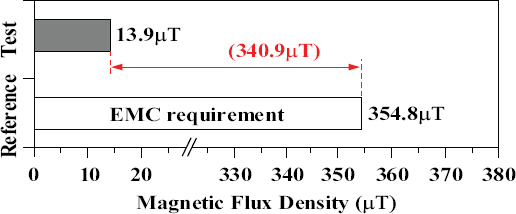
4. кІ° лЎ
ліё м—°кө¬м—җм„ңлҠ” мң лҸ„к°Җм—ҙмқ„ нҷңмҡ©н•ң мҪҳнҒ¬лҰ¬нҠё мҙү진양мғқм—җ мһҲм–ҙм„ң, кұ°н‘ём§‘мқҳ нҒ¬кё°м—җ л”°лҘё л°ңм—ҙнҡЁмңЁ, к°•лҸ„мҲҳмӨҖмқ„ кі л Өн•ң мҪҳнҒ¬лҰ¬нҠё л°°н•©лі„ мң лҸ„к°Җм—ҙ м–‘мғқ нӣ„ мЎ°кё°к°•лҸ„ нҸүк°Җ л°Ҹ мң лҸ„к°Җм—ҙ мӢңмқҳ м „мһҗнҢҢ мң н•ҙм„ұмқ„ нҸүк°Җн•ҳмҳҖлӢӨ. к·ё кІ°кіј ліё м—°кө¬мқҳ лІ”мң„ лӮҙм—җм„ң лӢӨмқҢкіј к°ҷмқҖ кІ°лЎ мқ„ лҸ„м¶ңн•ҳмҳҖлӢӨ.
(1) кұ°н‘ём§‘ мң лҸ„м—җ мқҳн•ң мҪҳнҒ¬лҰ¬нҠё к°Җм—ҙм–‘мғқм—җ мһҲм–ҙм„ң мҪҳнҒ¬лҰ¬нҠё лӢЁл©ҙм Ғмқҙ 150 mmм—җм„ң 300 mmлЎң мҰқк°Җн• кІҪмҡ° м „лӢЁл©ҙмқҳ кі лҘё мҳЁлҸ„분нҸ¬ м„ұлҠҘмқҖ к°җмҶҢн•ҳлҠ” кІғмңјлЎң лӮҳнғҖлӮ¬лӢӨ. мқҙлҹ¬н•ң л¬ём ңлҠ” лӢЁл©ҙ лӮҙл¶Җм—җ 추к°ҖлЎң мң лҸ„ л°Ҹ м—ҙм „лӢ¬мқҙ к°ҖлҠҘн•ң мһ¬лЈҢлҘј л„Јм–ҙмӨҢмңјлЎң мқён•ҙ мқјм •л¶Җ분 ліҙмҷ„мқҙ к°ҖлҠҘн•Ёмқ„ нҷ•мқён•ҳмҳҖлӢӨ.
(2) мҪҳнҒ¬лҰ¬нҠё л¬ј/мӢңл©ҳнҠё 비м—җ кҙҖкі„м—Ҷмқҙ 5 В°C мқҙн•ҳмқҳ м ҖмҳЁм—җм„ң м–‘мғқлҗң мҪҳнҒ¬лҰ¬нҠёмқҳ 15мӢңк°„ 압축강лҸ„лҠ” 0.2~0.3 MPaлЎң мЎ°кё°к°•лҸ„ л°ңнҳ„мқҙ кұ°мқҳ 진н–үлҗҳм§Җ м•ҠмқҢмқ„ нҷ•мқён•ҳмҳҖлӢӨ. мғҒмҳЁм–‘мғқ мҪҳнҒ¬лҰ¬нҠёмқҳ кІҪмҡ°, л¬ј/мӢңл©ҳнҠё 비мқҳ мҰқк°Җм—җ л”°лқј мЎ°кё° 압축강лҸ„лҠ” к°җмҶҢн•ҳлҠ” кІ°кіјлҘј нҷ•мқён•ҳмҳҖлӢӨ.
(3) 0Лҡ Cмқҳ м ҖмҳЁ мұ”лІ„м—җм„ң кұ°н‘ём§‘ мң лҸ„м—җ мқҳн•ҙ к°Җм—ҙ м–‘мғқлҗң мҪҳнҒ¬лҰ¬нҠёмқҳ 15мӢңк°„ 압축강лҸ„ м•Ҫ 16.2~25.7 MPaлЎң н•ңмӨ‘ мҪҳнҒ¬лҰ¬нҠёмқҳ м–‘мғқмў…лЈҢ к°•лҸ„лҘј мғҒнҡҢн•ҳмҳҖмңјл©°, мғҒмҳЁм–‘мғқ мҪҳнҒ¬лҰ¬нҠё лҢҖ비 м•Ҫ 135%~173%мқҳ к°•лҸ„ л°ңнҳ„мңЁмқ„ лӮҳнғҖлӮҙм—ҲлӢӨ. л”°лқјм„ң лҸҷм Ҳкё° мң лҸ„к°Җм—ҙ м–‘мғқмқ„ нҶөн•ҙ 15мӢңк°„ мқҙлӮҙм—җ 충분н•ң мЎ°кё°к°•лҸ„лҘј нҷ•ліҙн• мҲҳ мһҲмқҢмқ„ нҷ•мқён•ҳмҳҖлӢӨ.
(4) л¬ј/мӢңл©ҳнҠёл№„к°Җ лӮ®мқ„мҲҳлЎқ мң лҸ„к°Җм—ҙ кё°л°ҳ л°ңм—ҙм–‘мғқм—җ мқҳн•ң мҲҳнҷ” к°ҖмҶҚнҡЁкіјк°Җ мҰқк°Җн•ҳм—¬ мЎ°кё°к°•лҸ„ л°ңнҳ„м—җ нҡЁмңЁм Ғмһ„мқ„ нҷ•мқён•ҳмҳҖлӢӨ.
(5) м „мһҗнҢҢ мң н•ҙм„ұ кІҖнҶ кІ°кіј, мң лҸ„к°Җм—ҙ м–‘мғқ мӨ‘ л°ңмғқлҗҳлҠ” мһҗкё°мһҘмқҳ мһҗмҶҚл°ҖлҸ„лҠ” м „мһҗнҢҢ м Ғн•©м„ұ кё°мӨҖмқҳ 5% мқҙн•ҳлЎң мң н•ҙм„ұмқҙ м—ҶмқҢмқ„ нҷ•мқён•ҳмҳҖлӢӨ. к·ёлҹ¬лӮҳ мӢӨм ң нҳ„мһҘ мЎ°кұҙмқҳ мһҘ비 л°Ҹ кұ°н‘ём§‘мқ„ нҷңмҡ©н•ҳлҠ” кІҪмҡ°м—җ лҢҖн•ҙм„ңлҠ” лі„лҸ„мқҳ кІҖнҶ к°Җ н•„мҡ”н• кІғмңјлЎң нҢҗлӢЁлҗңлӢӨ.
к°җмӮ¬мқҳ кёҖ
ліё м—°кө¬лҠ” көӯнҶ көҗнҶөл¶Җ көӯнҶ көҗнҶөкё°мҲ мҙү진연кө¬мӮ¬м—…мқҳ м—°кө¬л№„м§Җмӣҗ(20CTAP-C152012-02)м—җ мқҳн•ҙ мҲҳн–үлҗҳм—ҲмҠөлӢҲлӢӨ.
References
1. ACI Committee 306R (1988) Cold weather concreting.
American Concrete Institute.

2. Kang, H.Y, Han, S.G, Kim, Y.S, and Nam, J.S (2009) A new construction field of Kyeryong Construction &Industrial Co., Ltd. Richeville in Russia Khabarovsk:An application of concrete placement in severe cold weather environment.
Magazine of the Korea Concrete Institute, Vol. 21, No. 2, pp. 62-66.

3. Kim, D.J, Choi, Y.S, Jeong, H.J, Shin, H.O, and Ahn, C.H (2020) Analysis of temperature distribution of mold for curing concrete based on induction heating.
Journal of the Korean Institute of Illuminating and Electrical Installation Engineers, Vol. 34, No. 10, pp. 16-23.

4. Koh, K.T, Cheong, H.M, Yoon, G.W, and Lee, J.H (2005) Properties of concrete to curing temperature.
Magazine of the Korea Concrete Institute, Vol. 17, No. 1, pp. 22-27.

5. Koh, T, Hwang, S, Moon, D, Yoo, J, Song, J, and Ko, J (2014) Early strength development of concrete cured with microwave heating form.
Journal of the Korean Society for Railway, Vol. 17, No. 5, pp. 365-372.


6. Korea Concrete Institute (KCI) (2015).
KCI PM303.1-15:Concrete curing. Seoul: KCI.

7. KS F 2402 (2017) Standard test method for concrete slump.
Korean Agency for Technology and Standards.

8. KS F 2405 (2010) Standard test method for compressive strength of concrete.
Korean Agency for Technology and Standards.

9. Lee, J.B, Kim, K.T, Ahn, C.H, Back, J.H, and Shin, H.O (2019) Compressive strength of heat-cured concrete based on induction heating.
J. Korean Soc. Hazard Mitig, Vol. 19, No. 7, pp. 331-337.


10. Mehta, P.K, and Monteiro, P.J (2006).
Concrete:microstructure, properties, and materials. 3rd ed. New York, NY, USA: McGraw-Hill.

11. Ministry of Land, Infrastructure and Transport (MOLIT) (2016)
Concrete standard specification.

12. National Radio Research Agency (RRA) (2019)
Electro magnetic compatibility.

13. Neville, A.M (1995).
Properties of concrete. 4th ed. London, UK: Longman.
















